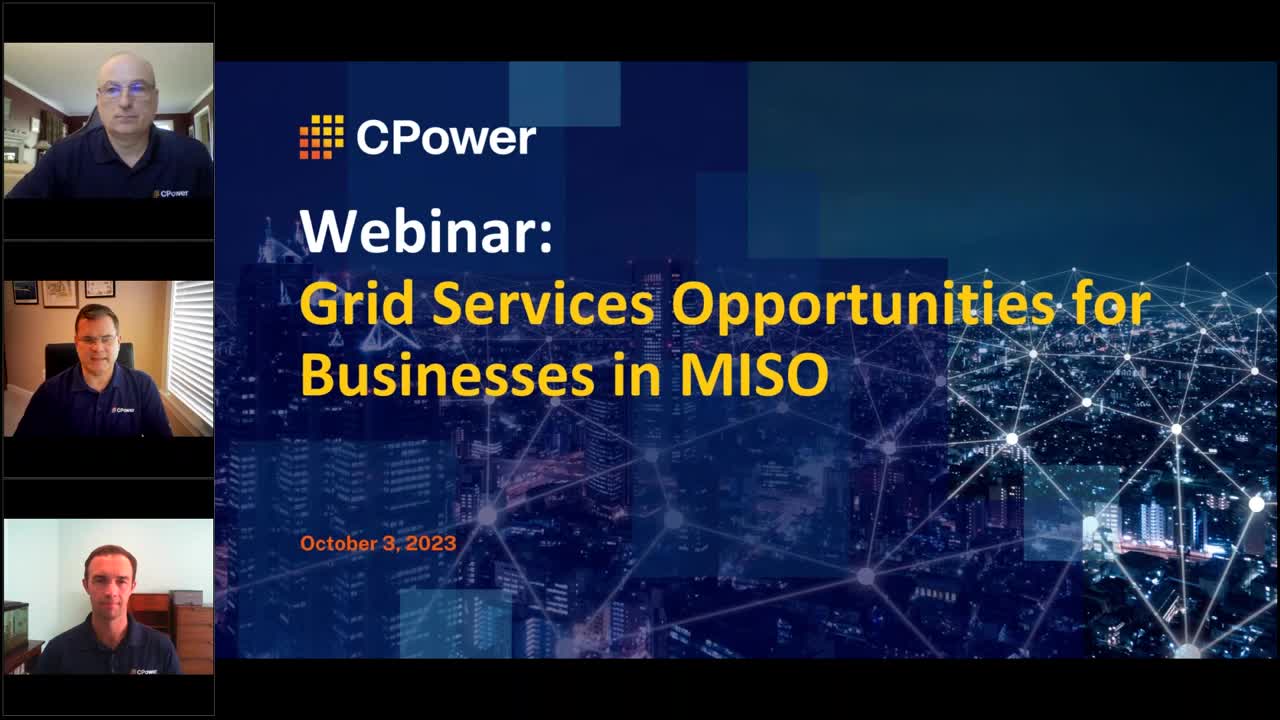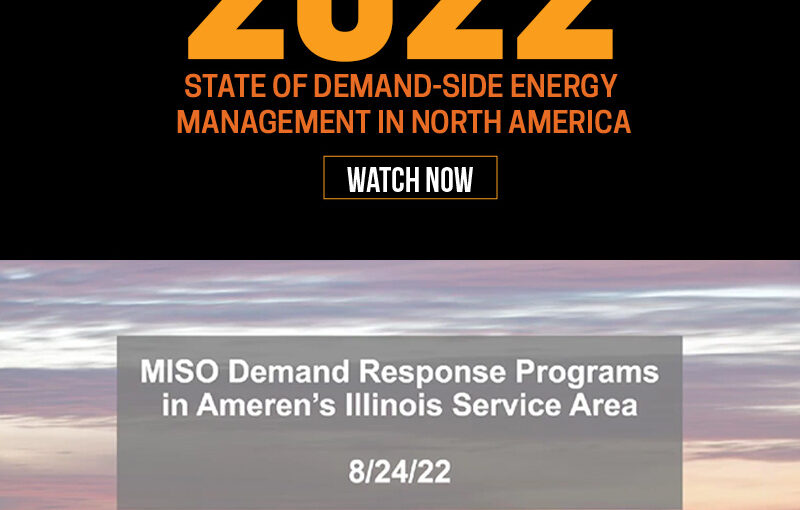A Powerful Opportunity: Capacity Concerns Make Grid Services Valuable for Businesses in MISO

Possible shortfalls in regional electricity capacity could disrupt business operations in the Midwest if the grid does not maintain balance as it shifts to clean energy. Fossil-fueled generators are retiring faster than renewable energy resources are coming online, leading analysts to warn of mounting reliability risks. However, commercial and industrial energy users in MISO can help the region’s grid operator keep the lights on and be financially rewarded for doing so. Learn how organizations reduce energy costs and receive payments for providing valuable grid services when the grid is stressed.
In this informative webinar, CPower will explore the details of how Midcontinent Independent System Operator (MISO) grid services work and what opportunities provide the most opportunity for energy users to achieve financial rewards for supporting the grid. In addition to making money and reducing their electricity costs, many businesses use their grid services earnings to progress their operational and decarbonization goals.
Midwestern State Regulatory Commissions, Electric Cooperatives and Municipal Electric Utilities Can Increase Demand Response Participation While Protecting Local Jurisdiction

The 2022-2023 Winter Reliability Assessment from the North American Electric Reliability Corporation (NERC) warns that a large portion of the North American bulk power system is at risk of having insufficient energy supplies during severe winter weather, including the Midwest, which is one of several regions that NERC oversees to maintain grid reliability. However, many Midwest municipal utilities and electric cooperatives lack a key grid-balancing tool that is common in other parts of the country: demand response (DR).
Midwestern state regulatory commissions, electric cooperatives and municipal electric utilities have long been reluctant to permit aggregators of retail customers (ARCs) to provide DR solutions in regional transmission organization/independent system operator (RTO/ISO) markets and utility programs. As a result, ARCs are not as prevalent in the Midcontinent Independent System Operator, Inc. (MISO) and Southwest Power Pool (SPP) markets as they are in most wholesale electricity markets in North America and throughout the world.
While the reasons that have led to limiting the ability of ARCs to operate in the Midwest are as much historical as regulatory in nature, the operational and financial impacts are here now. When there is not adequate supply to meet resource adequacy needs, clearing prices in capacity markets can soar and grid operators may struggle to maintain reliability.
For example, in MISO’s 2022/23 Planning Resource Auction, the North and Central regions were 1.23 GW short of meeting the Planning Reserve Margin Requirements established for the auction. This resulted in prices in these regions clearing at the cost of new entry, the administratively set price of how much it would cost to build a new generator.
A lack of ARCs could further affect the Midwest in years to come as intermittent energy resources become more common and energy consumption patterns shift more dramatically. New resources are needed to provide the grid flexibility necessary to ensure the long-term reliability of the grid.
If allowed, ARCs could provide more grid flexibility in the Midwest by deploying portfolios of demand response resources to quickly meet resource adequacy requirements and maintain system balance as intermittent supply resources replace traditional generation. Therefore, ARC-enabled demand response could protect the region against immediate threats like the tight generation supply conditions that NERC has warned about for this upcoming winter, as well as help bring about a customer-powered grid that supports a flexible, clean and dependable energy future and helps reduce consumer electricity costs.
Fortunately, relevant electric retail regulatory authorities (RERRAs) in the Midwest could increase demand response participation and more greatly leverage the efficiency and reliability benefits and technology innovation that ARCs bring to electricity markets, while at the same time safeguarding and respecting state commission regulatory jurisdiction and the self-regulation policies of municipal utilities and electric cooperatives.
The ARC Dilemma and a RERRA Solution
In what came to be known as the “Opt-Out/Opt-In Rule,” the Federal Energy Regulatory Commission (FERC) issued Order No. 719 in 2008, which gave states the final say about whether ARCs can participate in RTO/ISO DR programs. The opt-out rule has created a stalemate for demand response programs in the Midwest because state regulatory commissions, electric cooperatives and municipal electric utilities have worried whether and to what extent they could regulate ARCs and whether ARC activities would conflict with utility resource planning activities or otherwise interfere with rate regulation and unfairly shift costs to other ratepayers.
However, RERRAs have several avenues for asserting jurisdiction over ARCs and ARC activities pursuant to traditional regulatory authorities under state laws. Furthermore, the Opt-Out/Opt-In Rule itself is a powerful tool for RERRAs to exercise jurisdiction to regulate ARCs authorized under federal law.
Lessons Learned from ARC Regulation by RERRAs
State commissions, electric cooperatives and municipal electric utilities interested in exploring new ways to stabilize the grid amidst tightening reserve margins and mounting needs for flexible resources and lower costs can learn more about available options through a new whitepaper from CPower: Regulating Demand Response in the Midwest While Safeguarding Local Jurisdiction: A Guide for State Regulatory Commissions, Electric Cooperatives and Municipal Electric Utilities. The whitepaper outlines a helpful framework for how state regulators in the Midwest can facilitate the benefits that ARCs offer to increase DR participation, while also addressing the basis for state regulation of ARCs and regulators’ primary concerns. Gain insight on how to:
-
- Harness more flexibility through load management
- Enable ARCs while maintaining regulatory oversight
- Utilize ARC-provided DR to meet Resource Adequacy needs
- Prepare for future grid needs and services
Download this whitepaper to learn more about state regulation of ARCs in the Midwest. We’d welcome the opportunity to discuss this further.
Peter Dotson-Westphalen
As CPower’s Sr. Director Market Development, Peter has advocated to advance DR/DER interests in ISO/RTO stakeholder groups and with state and federal regulatory bodies. He has also managed wholesale and retail demand response portfolios across the CAISO, ERCOT, MISO and NYISO markets. Peter has 15 years of experience in the energy industry, primarily focused on demand response.
Kenneth D. Schisler
Ken leads CPower’s regulatory and government affairs team, having previously served in similar roles at both Vicinity Energy and EnerNOC/Enel. He brings nearly three decades of policy leadership on innovation in clean and advanced energy technologies and collaborates with public officials, regulators, power exchange and system operators, academia and industry peers to unleash the potential of demand-side resources.
MISO Demand Response Programs in Ameren’s Illinois Service Area

Explore the future of energy reliability in Illinois with CPower’s experts. You will learn about Midcontinent Independent System Operator (MISO) energy capacity trends and how you can reduce your operating costs while increasing sustainability and profitability. Our experts will provide a framework to help you manage energy cost challenges, find opportunities for new revenue and navigate solutions that can further improve your operational and sustainability initiatives.





